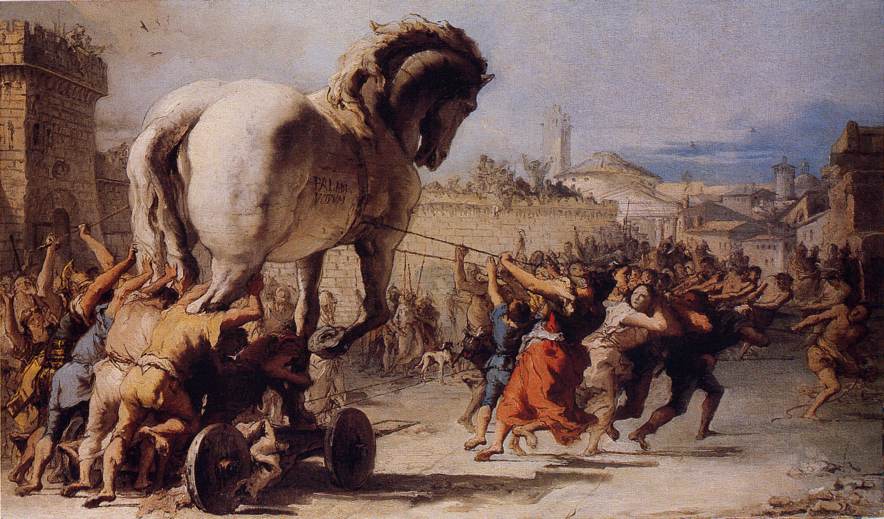The Trojan War has captivated the imaginations of people for centuries, with its tales of heroic battles, cunning deception, and the devastating consequences of human conflict. Amidst the rich tapestry of this legendary saga, one remarkable artifact has emerged as a poignant testament to the enduring power of artistic expression to capture the complexities and tragedies of the human experience – the Mykonos vase.
Discovered in 1961 on the picturesque Greek island of Mykonos, this large pithos, dating back to around 670 BC, has become a centerpiece of the island’s Archaeological Museum, offering a unique window into the Archaic period and the lasting legacy of the Trojan War. Through its intricate artistic depictions and symbolic representations, the Mykonos vase invites us to delve deeper into the human stories that unfolded during one of the most pivotal conflicts in ancient history.
Artistic Depiction on the Vase

The design of the Mykonos vase is divided into distinct segments, each revealing a different facet of the Trojan War narrative. The uppermost section captures the iconic Trojan Horse, surrounded by Greek warriors peeking from the horse’s portholes, a testament to the cunning deception that ultimately led to the downfall of Troy.
Beneath this iconic scene, three rows of metopes depict poised figures, hinting at the impending battle that would soon unfold. However, the true emotional impact of the vase’s artistic rendition lies in the bottom portion, where the formulaic depiction of the warriors takes a stark turn.
Unlike the warriors portrayed in the upper metopes, the figures on the main body of the pithos appear without shields, engaging directly with defenseless Trojan women and children, their expressive gestures and thick tresses conveying the raw anguish and vulnerability of the victims.
Symbolism and Interpretation
The Mykonos vase’s unique approach to illustrating the sack of Troy offers a profound commentary on the nature of human conflict. By focusing on the deceptive Trojan Horse and the ensuing massacre, rather than the battlefield’s front lines, the vase’s artistic rendition suggests a critique of the Greeks’ merciless tactics and the devastating toll they took on the innocent.
The separation of scenes into slaughter and deception emphasizes the brutality of the sack, drawing the viewer’s attention to the personal toll of the conflict. Noteworthy figures, such as the warrior drawing his sword, the woman clasping her hands in despair, and the fallen warrior beside his shield, underscore the individual suffering amidst the widespread violence, evoking a deeper empathy for the victims of the Trojan War.
Thematic Depth
 b
b
The layout of the Mykonos vase resists a straightforward chronological narrative, challenging the viewer’s perspective by juxtaposing the internal view from the horse’s portholes with the external havoc. This artistic strategy not only draws the viewer into the Trojan experience but also encourages a deeper reflection on the tragic consequences of the conflict beyond the legendary deceit that precipitated it.
Through its detailed portrayals and symbolic representations, the Mykonos vase offers more than an archaeological curiosity; it provides a profound commentary on the nature of human conflict, the deceit that can precede destruction, and the innocent lives that bear the consequences. As a pivotal piece of Archaic period art, the Mykonos vase stands as a testament to the enduring power of artistic expression to capture the complexities and tragedies of the human experience.
The Enduring Legacy of the Mykonos Vase
The Mykonos vase serves as a poignant reminder that the Trojan War was not merely a distant historical event, but a profound human tragedy that continues to resonate with us today. Its artistic depictions and symbolic representations challenge us to confront the darker aspects of our shared history, to reflect on the devastating consequences of war, and to consider the ways in which deception and brutality can overshadow the heroic narratives that often dominate our understanding of the past.

As we gaze upon the intricate details of the Mykonos vase, we are transported to a time of great upheaval and suffering, but also a time of remarkable artistic expression and enduring cultural significance. This remarkable artifact stands as a testament to the power of art to capture the complexities of the human experience, to give voice to the voiceless, and to inspire deeper reflection on the lessons we can learn from the tragedies of the past.
Whether you are a scholar of ancient history, an art enthusiast, or simply someone captivated by the enduring allure of the Trojan War, the Mykonos vase offers a unique and compelling window into this pivotal moment in human history. Its legacy continues to inspire and challenge us, reminding us of the profound impact that a single work of art can have in shaping our understanding of the world and our place within it.
